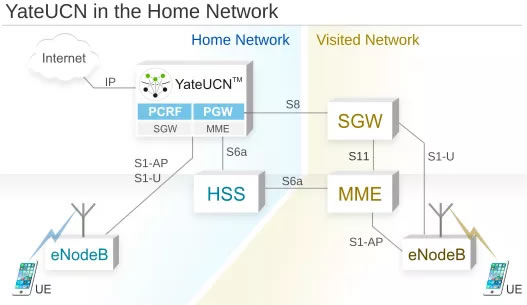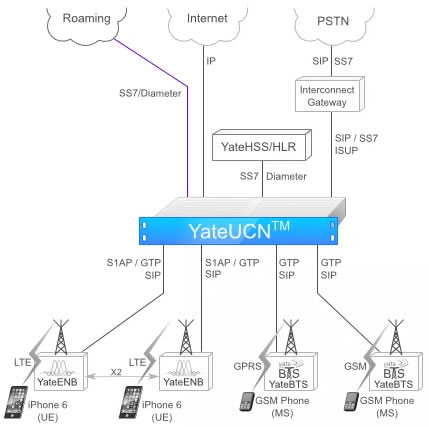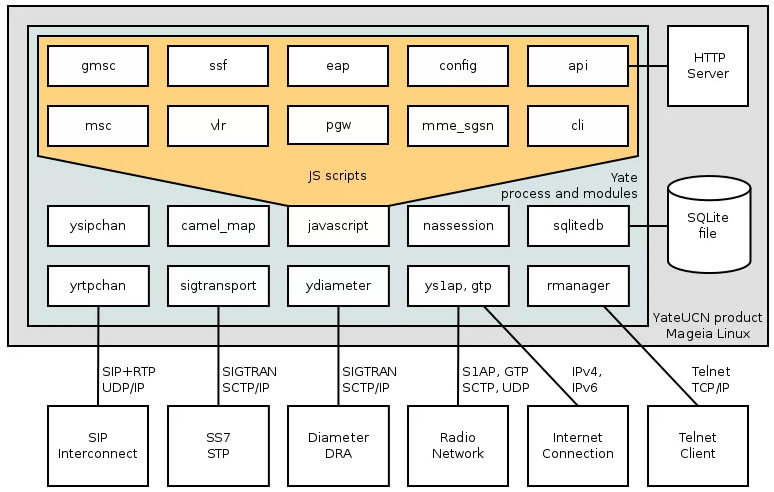About YateUCN, the GSM and LTE Core Network
Unified EPC/IMS core network
The YateUCN is a unified core network solution intended for new LTE networks, for upgrading GSM/GPRS networks to LTE or for extending existing LTE networks.
The YateUCN software-defined core implements all the functions and protocols of the LTE core network in software, and uses commodity hardware (e.g. Dell PowerEdge R430). It integrates the EPC layers – MME, PGW, SGW, and PCEF. The YateUCN also includes the IMS layers for VoLTE – PCSCF, ISCSCF, IWF, and BGW.
It communicates with the YateENB (LTE eNodeB module) over S1AP and GTP protocols and uses a JSON API for configuration and management.

Unified GSM/GPRS core network
The YateUCN also implements the functions and protocols of GSM/GPRS core networks. In GSM/GPRS, the YateUCN acts as a MSC/VLR/SGSN/GGSN/GMSC in a single server. It connects to the YateBTS (GSM module) over GTP and SIP, replacing the costly SS7 MAP-A interface (BSSAP protocol). This leads to a higher return on investment without affecting the reliability of the network or the provided services.
The unified core network solution is based on replacing the eNodeB with the YateENB (LTE) and the base station subsystem with the YateBTS (GSM).
Many areas in the world are not covered by a cellular network due to the cost of existing circuit-switched network technology. YateUCN brings a new solution for deploying GSM/LTE networks at a lower cost.
Remote access for operations and management
YateUCN is easy to operate and manage remotely using the Yate Mobile Management Interface (MMI). The interface makes it accessible to add a new YateUCN unit, to setup a cluster of YateUCNs, to configure a single YateUCN function (MSC/VLR, GMSC, SGSN, GGSN, SGW or PGW), to configure YateUCN equipment with all its GSM/GPRS/LTE functions and more.
YateUCN in a 4G Network
YateUCN is compatible to any 4G mobile network equipment, as seen in the diagram below.
It fulfills all the functions of the following typical SAE components:

Mobility Management Entity (MME)

Serving Gateway (SGW)

PDN Gateway (PGW)

Policy and Charging Enforcement Function (PCEF)

YateUCN Functionalities
As an MME
In its role as an MME, YateUCN performs network access control for UEs trying to connect to the IP network.
It is responsible for subscriber authentication by connecting over the S6a interface (Diameter) to the HSS, the central database containing network subscriber information.
YateUCN also handles mobility management, allowing UEs to have continuous connectivity and active sessions as they move through the network.
Acting as a fully fledged MME, YateUCN keeps track of idle UEs and sends paging messages to all the eNodeBs in the UEs’ tracking area and restores bearers, allowing new data sessions to be established.
As part of its mobility management functions, YateUCN handles roaming management for subscribers to other LTE or 2G/3G networks, also with the HSS. It does also support the MAP v3 protocol to a HLR.
YateUCN is responsible for radio resource management, communicating with both the eNodeBs in the RAN and the HSS to perform this task over the S1-AP and S6a (Diameter) interfaces.
As an SGW
As an SGW, YateUCN connects data sessions over GTPv2 based S5/S8 to a PGW and can also connect over GTPv1 Gn/Gp to a GGSN. It handles handover between eNodeBs over the S1 interface, acting as a data session anchor.
The data forwarding function can be bypassed completely when connected to the built-in PGW.
As a PGW
In its role as a PGW, YateUCN receives GTPv2 control messages, assigns IP addresses and routes IP packets to and from Internet. Once the MME within the YateUCN requests an IP address, the PGW allows the subscriber access to the network and assigns the UE an IP address. Connections and mobility from legacy 2G/3G SGSNs are supported over the GTPv1 based Gn/Gp interface with no performance penalty.
The S5/S8 interface is bypassed and no additional GTP traffic is generated when the built-in PGW is used locally.
As a PCEF
Acting as a PCEF YateUCN performs policy enforcement and service data flow detection, allowing data flow through the implemented PGW.
As a CSCF

IMS CSCF Description

IMS CSCF Configuration
Supported interfaces
YateUCN also supports the following LTE-specific protocol and interfaces:

S1AP (S1-MME)

GTP-U v1 (S1-U, Gn/Gp, S5/S8)

GTP-C v1 (Gn/Gp)

GTP-C v2 (S5/S8)

Diameter (S6a/S6d, S13, Cx/Dx)

ETSI MAP v3 (optional)

RADIUS (optional, custom Gz)

IP (SGi)
Roaming in a 4G network with YateUCN

As seen in the diagram above, YateUCN is deployed in the home network. It replaces the PGW and establishes the IP session.
It supports the GTP based S8 interface to connect to the visited SGW and performs signalling and IP traffic, enabling the subscriber access to both the Internet or the IMS network.

In a visited network, YateUCN will perform the typical functions of an SGW and an MME.
As a SGW, YateUCN enables signalling and IP traffic tunneling over the S8 interface to the home PGW.
YateUCN also supports the S6a interface to connect to the home HSS and S13 to connect to EIR.
YateUCN in a 2G Network
YateUCN is compatible to any 2G mobile network equipment.
It replaces the functions of the following 2G core network equipment:

Mobile Switching Center (MSC)

Visitor Location Register (VLR)

Serving GPRS support node (SGSN)

Gateway GPRS support node (GGSN)

Gateway Mobile Switching Center (GMSC)
As an MSC/VLR
YateUCN performs all the functions of a typical GSM MSC/VLR (Mobile Switching Center/Visited Location Register): authentication, routing calls and SMSs, handover, mobility.
YateUCN authenticates subscribers to the network using the SIM/USIM (EAP-SIM/EAP-AKA) and SIP AKAv1-MD5 algorithms.
Connection to and from YateUCN to the RAN network is performed via SIP/RTP.
Similar to any conventional MSC/VLR, YateUCN routes voice call, SMSs and any other circuit-switched services. YateUCN sends and receives SMSs using MAP/SIGTRAN and DIAMETER.
As a SGSN/GGSN
The GPRS data functions for 2.5G networks are supported in YateUCN. Connection to the RAN is purely GTPv1 with very little overhead.
As part of its data mobility management functions, YateUCN handles roaming management for subscribers to other 2G/3G or LTE networks to their HLR. It does also support the Diameter S6d to a HSS.
To enable future network development the SGSN can connect to a PGW using the GTPv2 based S5/S8 interface with no performance penalty.
The built-in GGSN/PGW function can be used to provide IP connectivity locally without going over a Gn/Gp interface.
YateUCN deployed in our Software-defined Mobile Network

Redundancy
In our Software-defined Core Network, redundancy is accomplished through SatSite’s ability to connect to another YateUCN in case the initial serving node malfunctioned. SatSite will choose from any of the YateUCN nodes stored in its list or will make a DNS request for a new node, irrespective of the geographical distance.
What’s more, when a device moves from one SatSite to another, it will continue to be served by the same YateUCN server, reducing the YateHSS/HLR load and allowing it to support more subscribers.
Features
SS7 Connectivity

Both IPv4 and IPv6 are supported

SIGTRAN, SCTP with CRC checksum

M2UA, M2PA, M3UA

ITU MTP, SCCP, TCAP

ANSI MTP, SCCP

ETSI MAP v3

CAMEL phase 2
Voice interconnect

Both IPv4 and IPv6 are supported

SIP and RTP

ISUP using SIGTRAN MTP and an external MGCP gateway
SCCP GTT

E.212 (ANSI)

E.214 (ITU) translation table

E.164
MSC/VLR

ETSI MAP v3

Supported operations:
- MSC <-> AuC messages (authentication)
- MSC <-> EIR messages (equipment identification, optional)
- VLR <-> HLR messages (location management, roaming)
- MSC <-> SMSC messages (SMS)
SGSN/MME

ETSI MAP v3

Diameter

S1AP r11

GTPv1 (Gn/Gp)

Supported operations:
- SGSN <-> AuC messages (authentication)
- SGSN <-> EIR messages (equipment identification, optional)
- SGSN <-> HLR messages (data mobility management, roaming)
- SGSN <-> GGSN messages (data sessions)
- YateENB <-> MME messages (LTE control and user data)
- YateBTS <-> SGSN messages (GPRS control and user data)
SIP/RTP

Supported standards (RFC3261)

Registrar function

B2BUA for calls

RTP (RFC3550) with sideband DTMF (RFC2833)

SMS and USSD over IP
SMS

Format: SMS PDU (MO and MT)

MAP/SS7 transport (T-PDU format)

SIP MESSAGE transport (SMS over IP, R-PDU format)
CDR

Diameter online and offline charging

RADIUS offline charging

Flexible file format
- Rotation interval
- File transfer: FTP
YateUCN architecture

In the above image you can see YateUCN’s architecture:

Yate C++ modules add support for various protocols: MAP, Diameter, CAMEL, GTP. These protocols are included only in the private version of Yate.

An application layer built in Javascript.
- A Javascript library that eases work with the protocol modules above.
- Various Js scripts that implement the actual logic of the YateUCN.
- Example of included scripts: ucn_mme_sgsn.jsc, ucn_msc.jsc, ucn_pgw.jsc, ucn_ssf.jsc, ucn_vlr.jsc, ucn_eap.jsc.
- The scripts use the Js library to communicate with the protocol modules and the Sqlite database.

Sqlite database to store registered users and their profiles.

Configuration and monitoring API built in Javascript/PHP
Remote access for YateUCN operations and management
YateUCN is easy to operate and manage remotely using the Yate Mobile Management Interface (MMI).
The interface makes it accessible to add a new YateUCN unit, to setup a cluster of YateUCNs, to configure a single YateUCN function (MSC/VLR, GMSC, SGSN, GGSN, SGW or PGW), to configure YateUCN equipment with all its GSM/GPRS/LTE functions and more. With YateMMI operators can remotely manage their entire network equipment using a single web interface.
